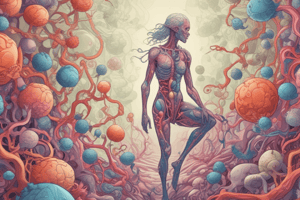Podcast
Questions and Answers
La función principal del sistema nervioso es transportar oxígeno a través del cuerpo.
La función principal del sistema nervioso es transportar oxígeno a través del cuerpo.
False
Los músculos esqueléticos están unidos a los huesos por ligamentos.
Los músculos esqueléticos están unidos a los huesos por ligamentos.
False
Las células del sistema digestivo ayudan a descomponer los alimentos en nutrientes absorvibles.
Las células del sistema digestivo ayudan a descomponer los alimentos en nutrientes absorvibles.
True
Los huesos largos, como el fémur y la tibia, son ejemplos de huesos planos en el cuerpo humano.
Los huesos largos, como el fémur y la tibia, son ejemplos de huesos planos en el cuerpo humano.
Signup and view all the answers
El ADN de una célula se encuentra principalmente en la mitocondria.
El ADN de una célula se encuentra principalmente en la mitocondria.
Signup and view all the answers
Study Notes
Human Biology: Understanding Our Anatomical Structure
Human biology encompasses various aspects of human life, from our physical structure to how we function internally. One key area within this field is anatomy, which focuses specifically on the study of the body's structures. To better understand the complexity and interconnectedness of these structures, let's delve into the world of human anatomy.
Body Systems Overview
The human body can be divided into several major systems that work together to maintain our health and wellbeing. These systems include:
-
Skeletal System: Comprised of bones and joints, the skeleton provides structure to our body while also protecting our organs. It is responsible for supporting movement through its connection with muscles.
-
Muscular System: Muscles are essential for movement and are attached to bones via tendons. They help control body posture and facilitate daily activities.
-
Nervous System: This system communicates between different parts of the body using electrical signals called nerve impulses. It controls actions like breathing, digestion, and thought processes.
-
Digestive System: This system breaks down food into nutrients that the body can use to grow and function properly. It includes organs such as the mouth, esophagus, stomach, small intestine, large intestine, liver, gallbladder, and rectum.
Cell Structure and Function
At the microscopic level, our bodies are made up of cells, which come together to form tissues and organs. The basic structure of a cell consists of:
- Cell membrane: A lipid layer that separates the cell from its environment and controls what enters and exits the cell.
- Nucleus: Contains the cell's DNA, which determines its characteristics and function.
- Cytoplasm: The gel-like substance within the cell that contains organelles, such as the mitochondria, which produces energy.
Anatomy of the Skeletal System
The skeletal system is a crucial part of the human body, providing support, protection, and facilitating movement. It is made up of bones, which are connected by joints. Bones are categorized as long bones (like the femur and tibia), short bones (like the wrist and ankle), flat bones (like the skull and ribs), and irregular bones (like the vertebrae and bones in the pelvis).
Anatomy of the Muscular System
The muscular system is responsible for movement and maintaining posture. Muscles are classified as smooth, skeletal, and cardiac muscles. Skeletal muscles are attached to bones by tendons and are responsible for voluntary movements. Smooth muscles are found in the walls of internal organs like the stomach and intestines and allow for involuntary movements. Cardiac muscles are found only in the heart and are responsible for pumping blood throughout the body.
Anatomy of the Nervous System
The nervous system is responsible for sending messages between different parts of the body. It is composed of the brain and spinal cord, which are the central components, and nerves that extend throughout the body. Neurons, or nerve cells, transmit messages from one part of the nervous system to another. There are two main types of neurons: sensory neurons, which transmit information from the senses to the central nervous system, and motor neurons, which carry signals from the central nervous system to muscles and glands.
Anatomy of the Digestive System
The digestive system is responsible for breaking down food and absorbing nutrients. This process occurs in several stages, including chewing, swallowing, digestion, absorption, and elimination. Major organs involved in this process include the mouth, esophagus, stomach, small intestine, large intestine, liver, gallbladder, and rectum. The walls of the digestive organs are lined with specialized cells that help break down food into nutrients like carbohydrates, proteins, and fats that can be absorbed by the body.
Conclusion
Understanding human anatomy is essential for understanding how our bodies function and respond to various stimuli. By studying the structures and components of each system, we gain a deeper appreciation for the intricate workings of our own bodies. This knowledge can also help us better understand diseases and conditions that may affect these systems, leading to more effective treatments and management strategies.
Studying That Suits You
Use AI to generate personalized quizzes and flashcards to suit your learning preferences.
Description
Explora la anatomía humana y aprende sobre los sistemas corporales clave, como el sistema esquelético, muscular, nervioso y digestivo. Descubre la estructura y función celular, así como la importancia de cada sistema para mantener la salud y el bienestar. Profundiza en el estudio de la anatomía humana para apreciar la complejidad de nuestro organismo.



